Mysql cluster high availability architecture MHA
1. Overview of MHA
1.1. What is MHA?
-
MHA (MasterHigh Availability) is an excellent set of failover and master-slave replication software in a MySQL high-availability environment.
-
The emergence of MHA is to solve the single point problem of MySQL.
-
During the MySQL failover process, MHA can automatically complete the failover operation within 0-30 seconds.
-
MHA can ensure data consistency to the greatest extent during the failover process to achieve true high availability.
1.2. Composition of MHA
MHA Node(数据节点)
MHA Node 运行在每台 MySQL 服务器上。
MHA Manager(管理节点)
- MHA Manager can be deployed on an independent machine to manage multiple master-slave clusters; it can also be deployed on a slave node.
- MHA Manager will periodically detect the master node in the cluster. When the master fails, it can automatically promote the slave with the latest data to the new master, and then redirect all other slaves to the new master. The entire failover process is completely transparent to the application.
1.3. Characteristics of MHA
-
During the automatic failover process, MHA attempts to save the binary log from the downed main server to ensure that data is not lost to the greatest extent;
-
Using semi-synchronous replication can greatly reduce the risk of data loss. If only one slave has received the latest binary log, MHA can apply the latest binary log to all other slave servers, thus ensuring the data consistency of all nodes. ;
-
Currently, MHA supports one master and multiple slaves architecture, with at least three services, that is, one master and two slaves.
2. MHA high availability instance
实验思路:
1.MHA架构
1)数据库安装
2)一主两从
3)MHA搭建
2.故障模拟
1)主库失效
2)备选主库成为主库
3)原故障主库恢复重新加入到MHA成为从库
| node server | CPU name | IP address | Installation services and tools |
|---|---|---|---|
| MHA manager node server | CentOS7.4(64 bit) | manager | 192.168.11.14 |
| Master node server | CentOS7.4(64 bit) | mysql1 192.168.11.11 | Install mysql5.7 and MHA node components |
| Slave1 node server | CentOS7.4(64 bit) | mysql2 192.168.11.12 | Install mysql5.7 and MHA node components |
| Slave2 node server | CentOS7.4(64 bit) | mysql3 192.168.11.13 | Install mysql5.7 and MHA node components |
2.1. Configure master-slave replication
初始化环境
#在四台服务器上初始化环境
systemctl stop firewalld
systemctl disable firewalld
setenforce 0




修改 Master、Slave1、Slave2 节点的主机名
#在Master上
hostnamectl set-hostname Mysql1
su
#在Slave1
hostnamectl set-hostname Mysql2
su
#在Slave2
hostnamectl set-hostname Mysql3
su



在Master、Slave1、Slave2添加域名解析
vim /etc/hosts
192.168.11.11 Mysql1
192.168.11.12 Mysql2
192.168.11.13 Mysql3



配置主从同步
#修改 Master、Slave1、Slave2 节点的 Mysql主配置文件/etc/my.cnf
##Master 节点##
vim /etc/my.cnf
[mysqld]
server-id = 1
log_bin = master-bin
log-slave-updates = true
systemctl restart mysqld
##Slave1 节点##
vim /etc/my.cnf
server-id = 2 #三台服务器的 server-id 不能一样
log_bin = master-bin
relay-log = relay-log-bin
relay-log-index = slave-relay-bin.index
systemctl restart mysqld
###Slave2 节点##
vim /etc/my.cnf
server-id = 3
log_bin = master-bin
relay-log = relay-log-bin
relay-log-index = slave-relay-bin.index
systemctl restart mysqld
##Master node##
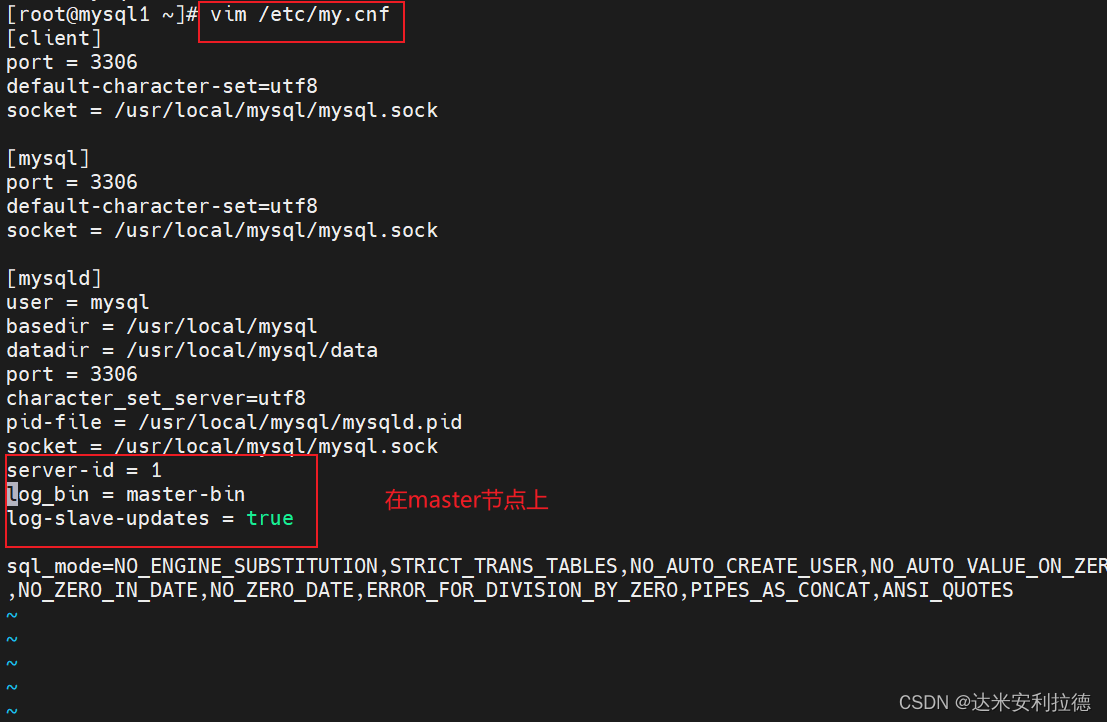

##Slave1 node##


##Slave2 node##
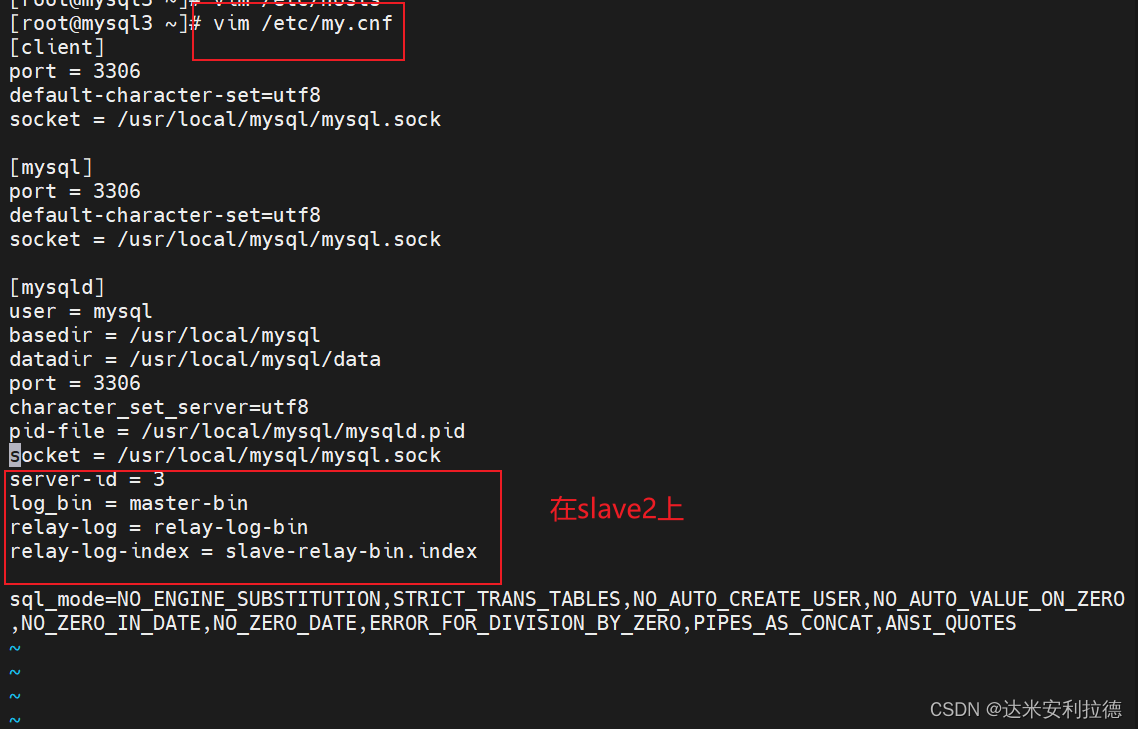

Master、Slave1、Slave2 节点上都创建两个软链接
ln -s /usr/local/mysql/bin/mysql /usr/sbin/
ln -s /usr/local/mysql/bin/mysqlbinlog /usr/sbin/
ls /usr/sbin/mysql*



登录数据库主从配置授权
###Master、Slave1、Slave2 节点上都授权###
grant replication slave on *.* to 'myslave'@'192.168.11.%' identified by '123123';
#授权主从用户
grant all privileges on *.* to 'mha'@'192.168.11.%' identified by 'manager';
grant all privileges on *.* to 'mha'@'Mysql1' identified by 'manager';
grant all privileges on *.* to 'mha'@'Mysql2' identified by 'manager';
grant all privileges on *.* to 'mha'@'Mysql3' identified by 'manager';
#刷新库
flush privileges;
###On the master node###

###On the slave1 node###
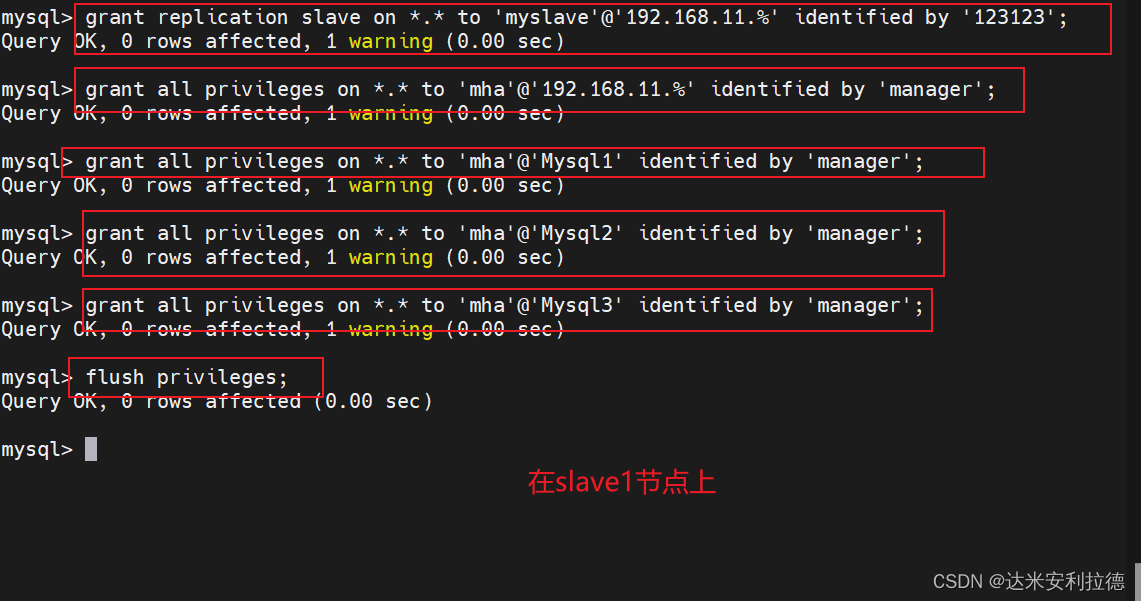
###On the slave2 node###
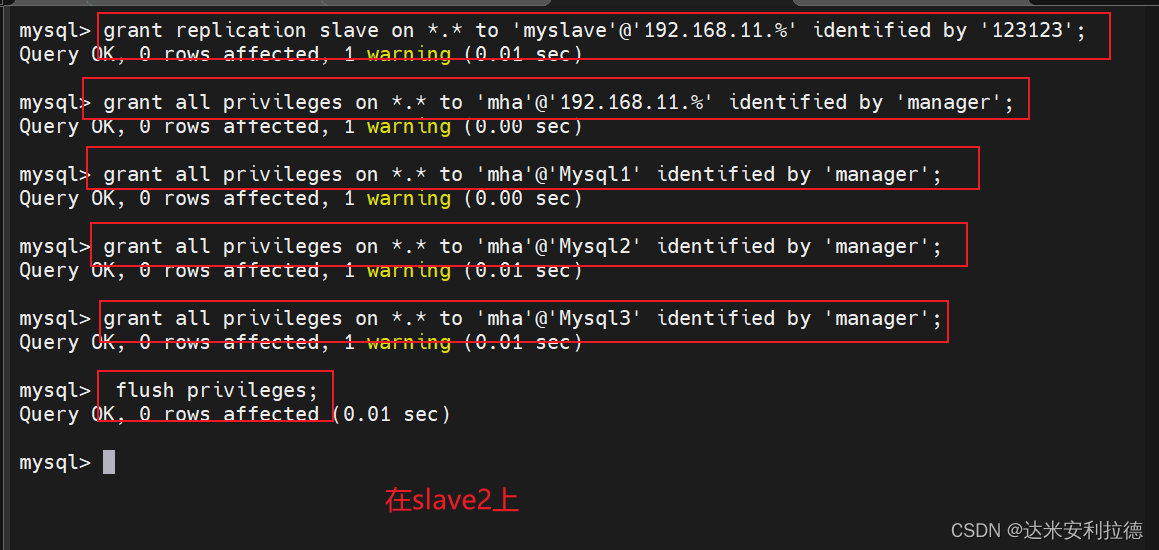
Master 节点查看二进制文件和同步点 、在 Slave1、Slave2 节点执行同步操作
###在master上###
show master status;
###在slave1、slave2节点执行同步操作##
change master to master_host='192.168.11.11',master_user='myslave',master_password='123123',master_log_file='master-bin.000001',master_log_pos=1745;
start slave;
show slave status\G;
###On master###

###On slave1###

###On slave2###
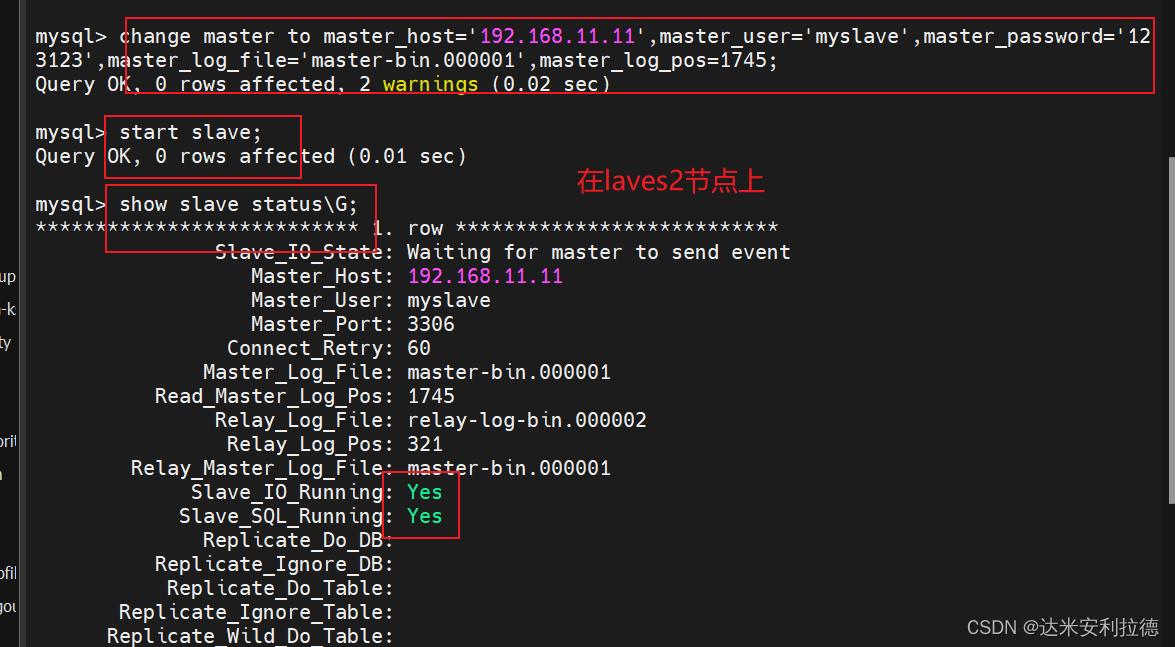
设置两个从节点 只读模式
set global read_only=1;


验证主从同步
##在主master上创建库、表并插入数据##
create database nba;
use nba;
insert into info values('小明');
select * from nba.info;
##在slave1、slave2上验证##
select * from nba.info;
##Create libraries, tables and insert data on the main master##
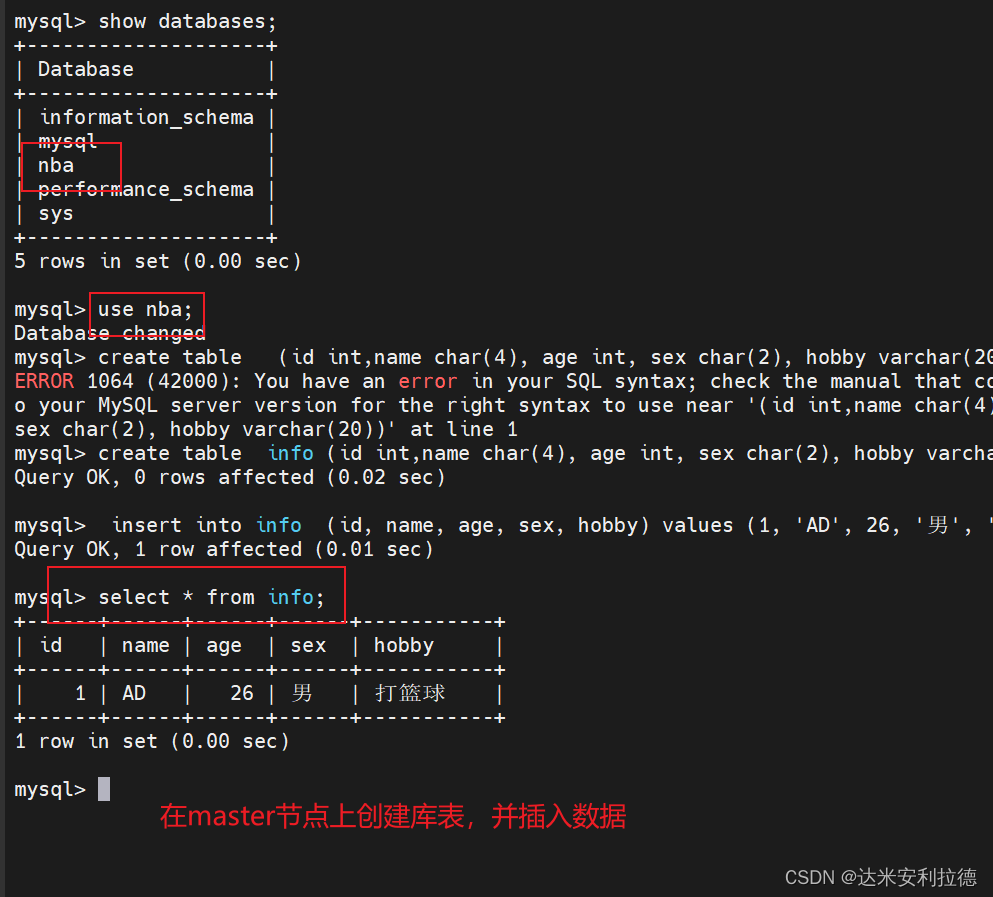
##Verify on slave1, slave2##
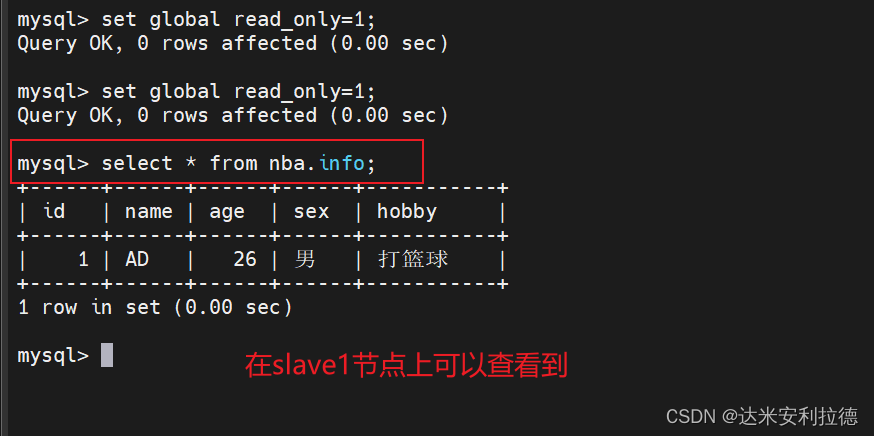

2.1. Install MHA software
所有服务器上都安装 MHA 依赖的环境,首先安装 epel 源
yum install epel-release --nogpgcheck -y
yum install -y perl-DBD-MySQL \
perl-Config-Tiny \
perl-Log-Dispatch \
perl-Parallel-ForkManager \
perl-ExtUtils-CBuilder \
perl-ExtUtils-MakeMaker \
perl-CPAN


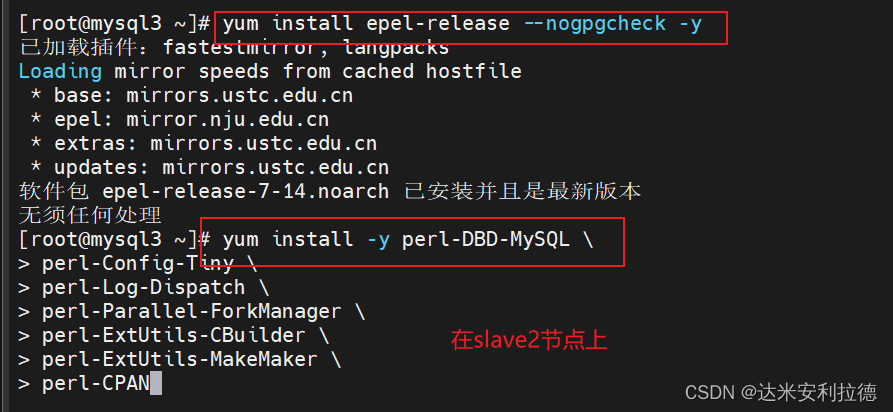
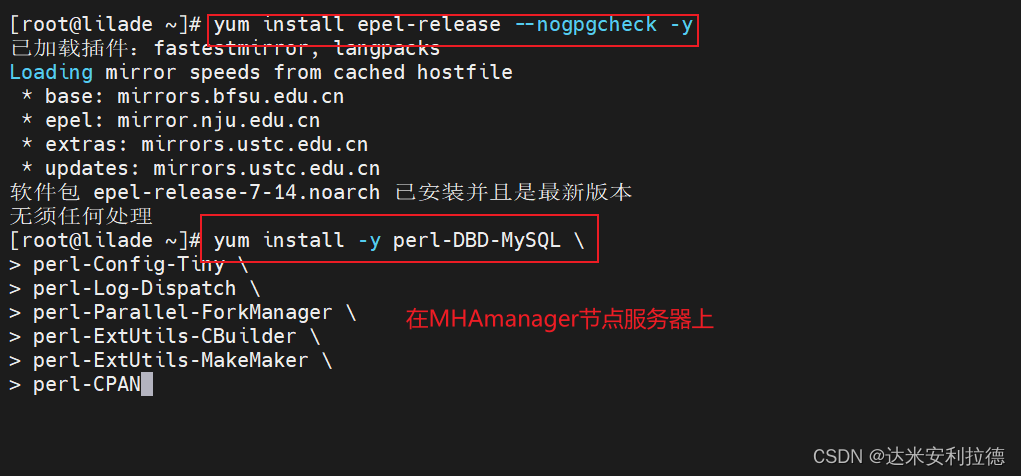
安装 MHA 软件包,先在所有服务器上必须先安装 node 组件
对于每个操作系统版本不一样,这里 CentOS7.4 必须选择 0.57 版本。
在所有服务器上必须先安装 node 组件,最后在 MHA-manager 节点上安装 manager 组件,因为 manager 依赖 node 组件。
##将需要的包下载到/opt下##
##每台服务器上解压安装node组件##
cd /opt
tar zxf mha4mysql-node-0.57.tar.gz
cd mha4mysql-node-0.57
perl Makefile.PL
make && make install
##Download the required packages to /opt##




##Unzip and install node components on each server##

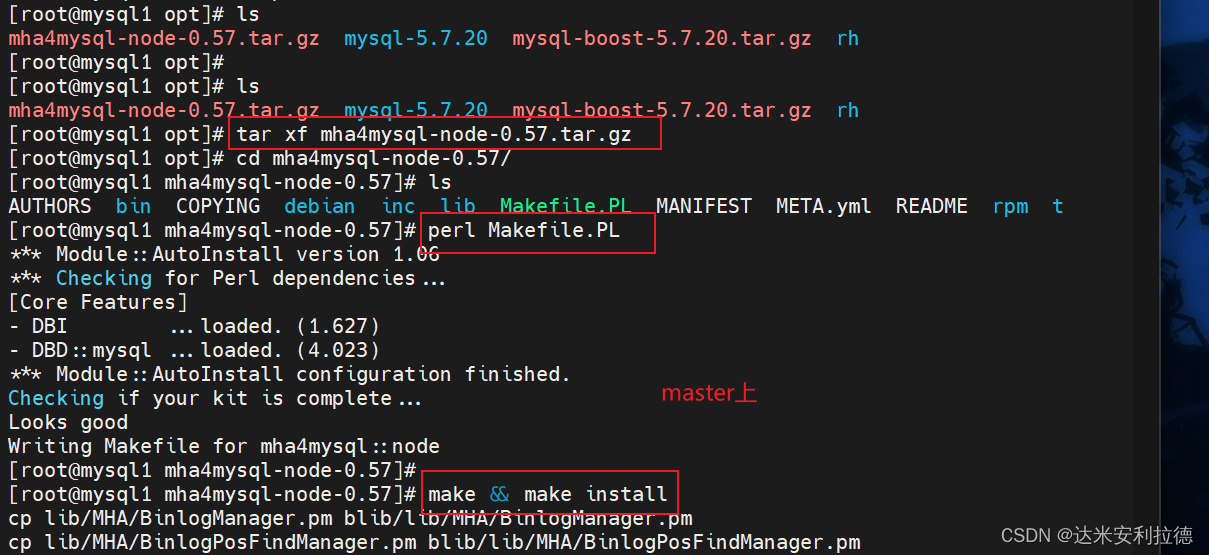
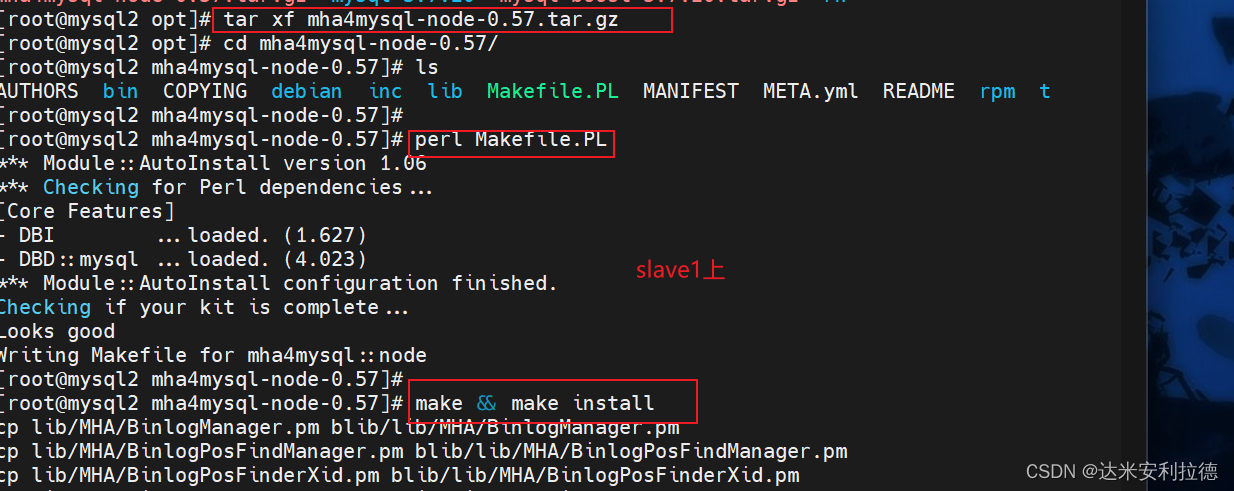
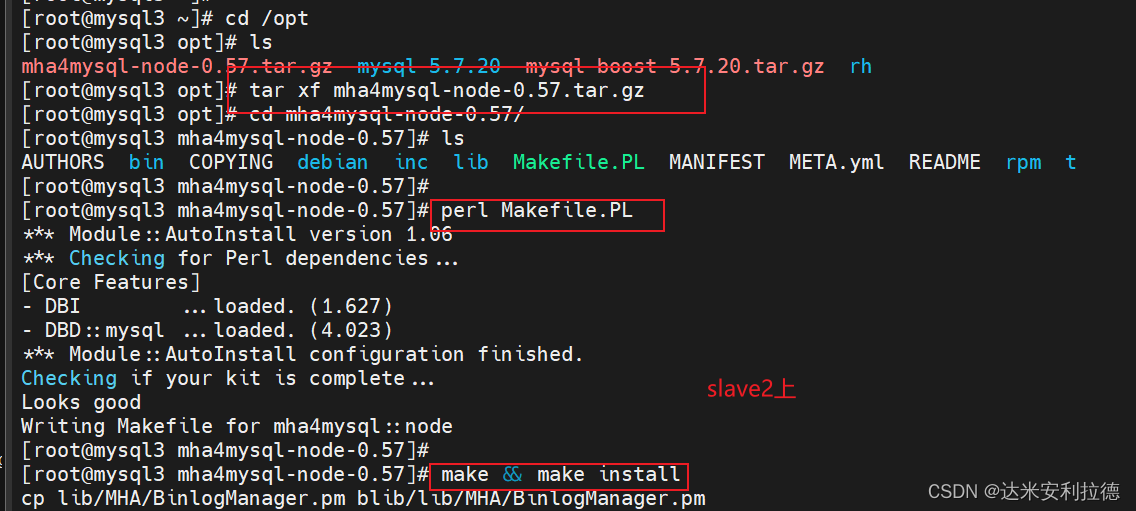
在 MHA-manager 节点上安装 manager 组件
tar zxf mha4mysql-manager-0.57.tar.gz
cd mha4mysql-manager-0.57/
perl Makefile.PL
make && make install

cd /usr/local/bin/
#manager 组件安装后在/usr/local/bin 下面会生成几个工具,主要包括以下几个:
masterha_check_ssh 检查 MHA 的 SSH 配置状况
masterha_check_repl 检查 MySQL 复制状况
masterha_manger 启动 manager的脚本
masterha_check_status 检测当前 MHA 运行状态
masterha_master_monitor 检测 master 是否宕机
masterha_master_switch 控制故障转移(自动或者 手动)
masterha_conf_host 添加或删除配置的 server 信息
masterha_stop 关闭manager
#node 组件安装后也会在/usr/local/bin 下面会生成几个脚本(这些工具通常由 MHAManager 的脚本触发,无需人为操作)主要如下:
save_binary_logs 保存和复制 master 的二进制日志
apply_diff_relay_logs 识别差异的中继日志事件并将其差异的事件应用于其他的 slave
filter_mysqlbinlog 去除不必要的 ROLLBACK 事件(MHA 已不再使用这个工具)
purge_relay_logs 清除中继日志(不会阻塞 SQL 线程)

在所有服务器上配置无密码认证
#在 manager 节点上配置到所有数据库节点的无密码认证
ssh-keygen -t rsa #一路按回车键
ssh-copy-id 192.168.11.11
ssh-copy-id 192.168.11.12
ssh-copy-id 192.168.11.13
####数据库服务器之间互相导入即可####
#在master上
ssh-keygen -t rsa #一路按回车键
ssh-copy-id 192.168.11.12
ssh-copy-id 192.168.11.13
#在slave1上
ssh-keygen -t rsa #一路按回车键
ssh-copy-id 192.168.11.11
ssh-copy-id 192.168.11.13
#在slave2上
ssh-keygen -t rsa #一路按回车键
ssh-copy-id 192.168.11.11
ssh-copy-id 192.168.11.12
#Configure passwordless authentication to all database nodes on the manager node
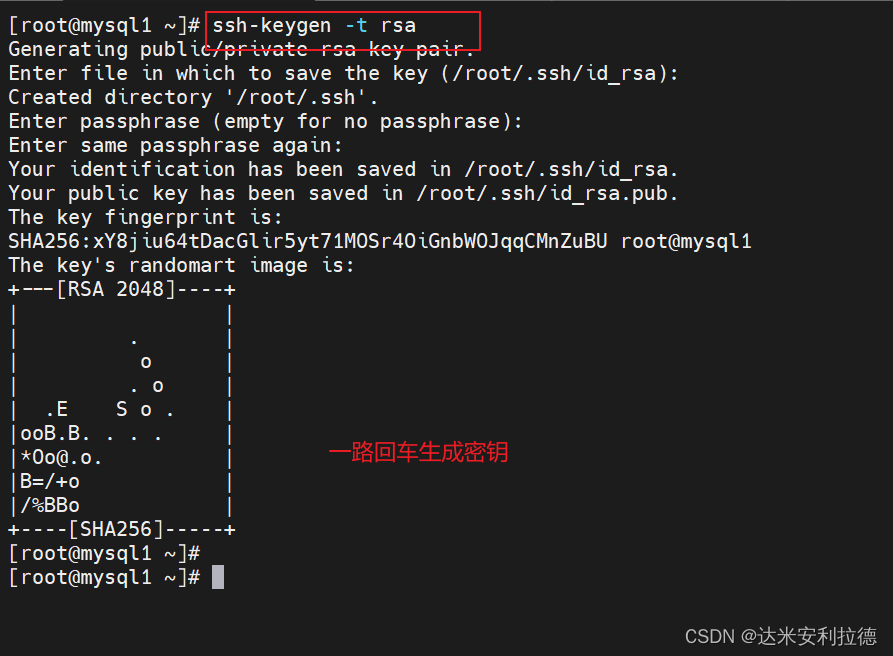
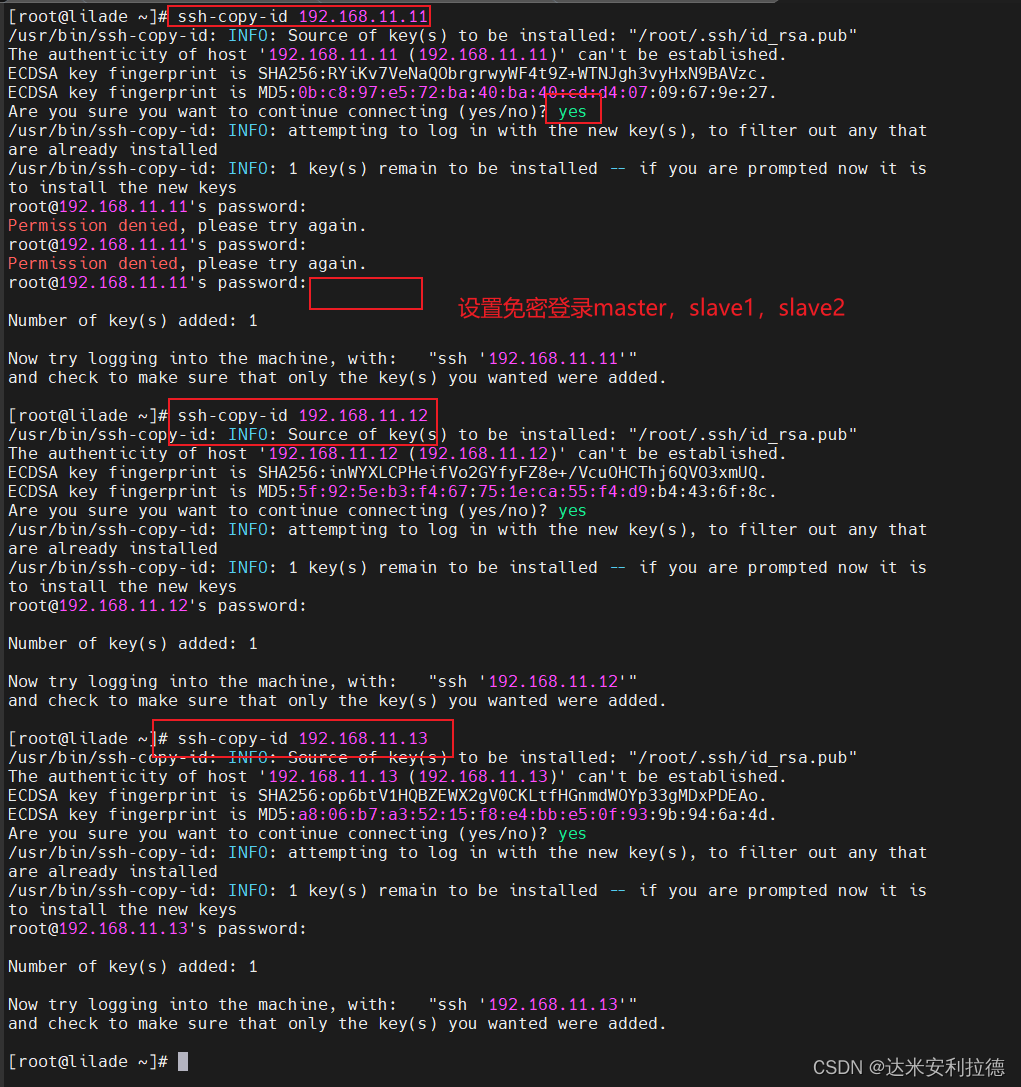
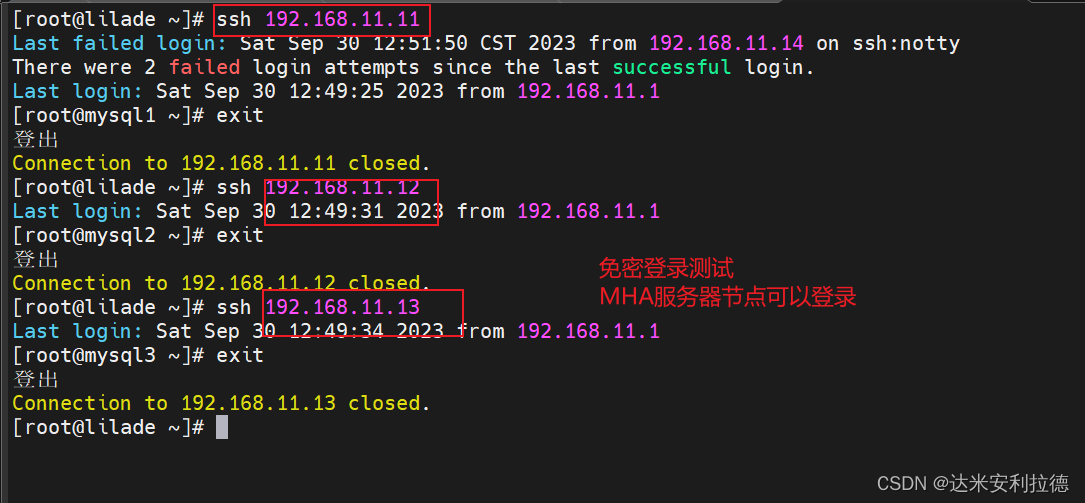
#On master

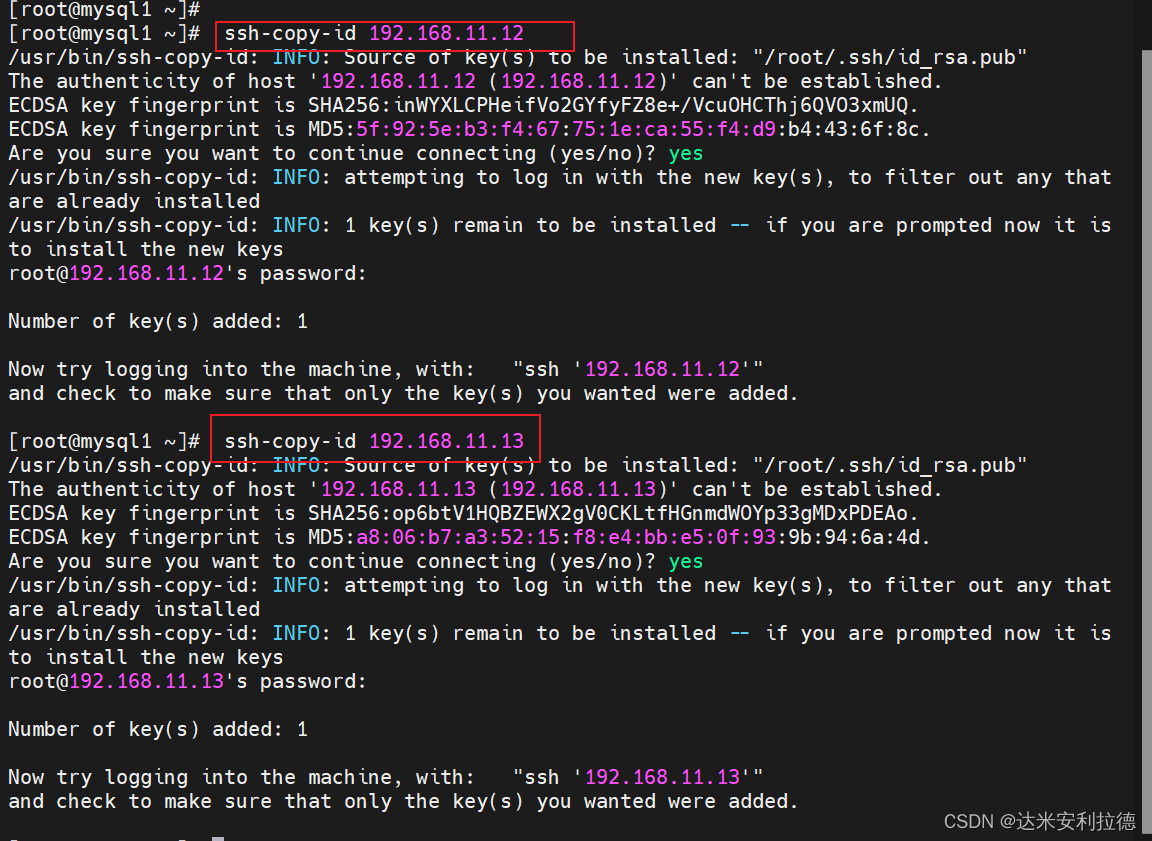
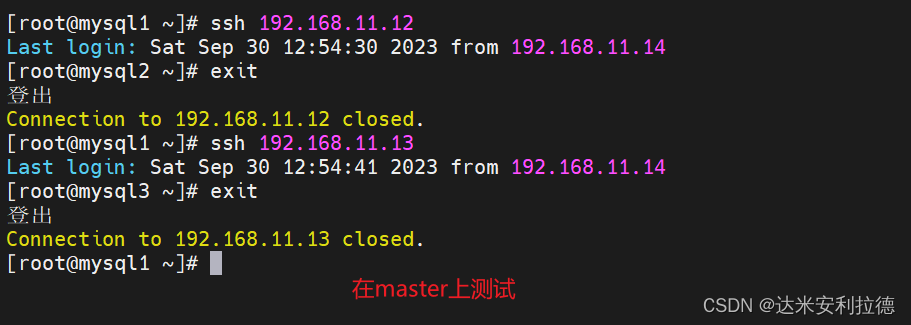
#On slave1

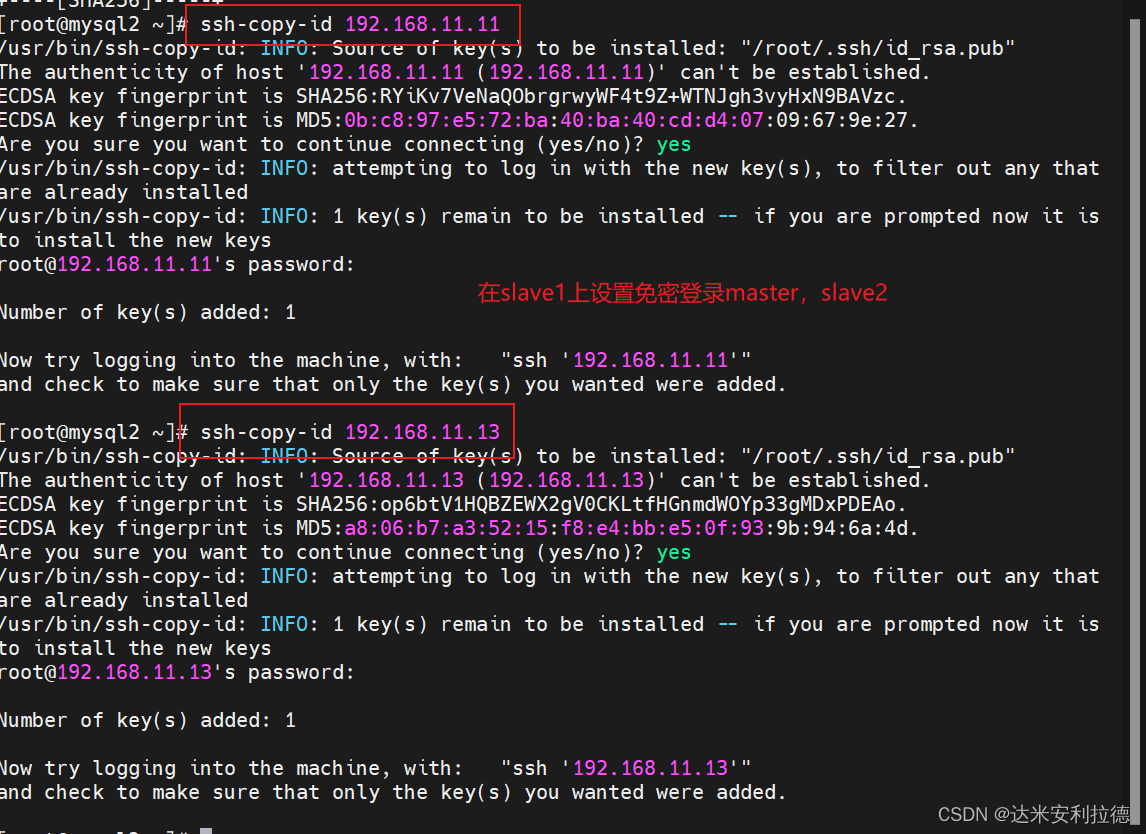
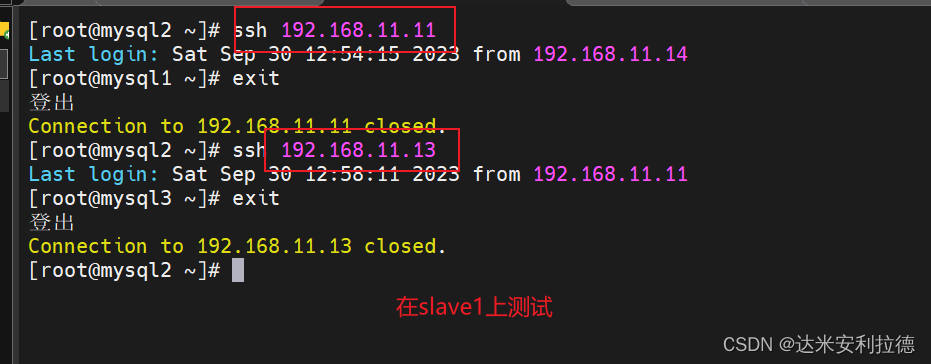
#on slave2
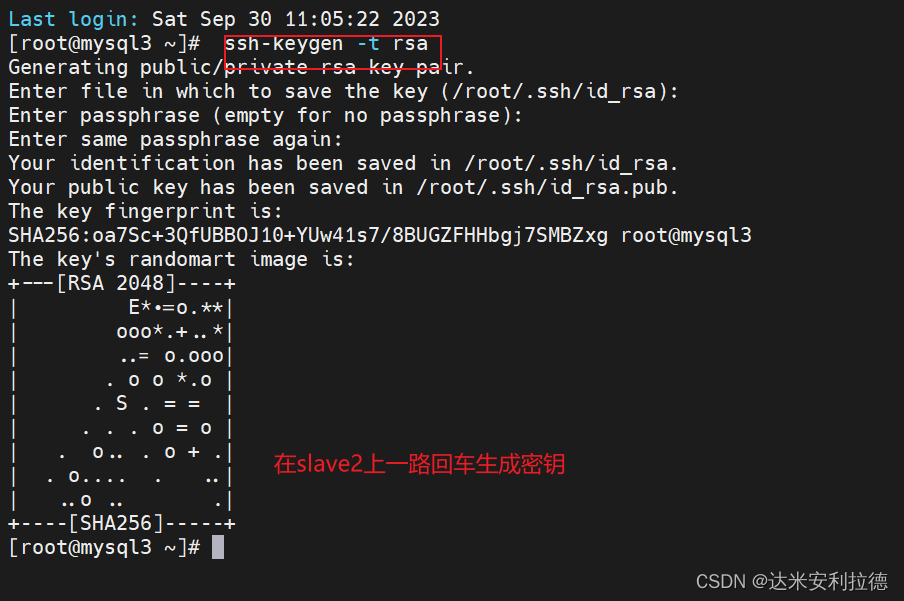


在manager节点上操作
(1)##在 manager 节点上复制相关脚本到/usr/local/bin 目录
cp -rp /opt/mha4mysql-manager-0.57/samples/scripts /usr/local/bin
#拷贝后会有四个执行文件
ll /usr/local/bin/scripts/
master_ip_failover #自动切换时 VIP 管理的脚本
master_ip_online_change #在线切换时 vip 的管理
power_manager #故障发生后关闭主机的脚本
send_report #因故障切换后发送报警的脚本
(2)##复制上述的自动切换时 VIP 管理的脚本到 /usr/local/bin 目录,这里使用master_ip_failover脚本来管理 VIP 和故障切换
cp /usr/local/bin/scripts/* /usr/local/bin
(3)##修改master_ip_failover 全部删除,添加以下内容,修改相关参数
#!/usr/bin/env perl
use strict;
use warnings FATAL => 'all';
use Getopt::Long;
my (
$command, $ssh_user, $orig_master_host, $orig_master_ip,
$orig_master_port, $new_master_host, $new_master_ip, $new_master_port
);
#############################添加内容部分#########################################
my $vip = '192.168.11.11'; #指定vip的地址
my $brdc = '192.168.11.255'; #指定vip的广播地址
my $ifdev = 'ens33'; #指定vip绑定的网卡
my $key = '1'; #指定vip绑定的虚拟网卡序列号
my $ssh_start_vip = "/sbin/ifconfig ens33:$key $vip"; #代表此变量值为ifconfig ens33:1 192.168.59.188
my $ssh_stop_vip = "/sbin/ifconfig ens33:$key down"; #代表此变量值为ifconfig ens33:1 192.168.59.188 down
my $exit_code = 0; #指定退出状态码为0
#my $ssh_start_vip = "/usr/sbin/ip addr add $vip/24 brd $brdc dev $ifdev label $ifdev:$key;/usr/sbin/arping -q -A -c 1 -I $ifdev $vip;iptables -F;";
#my $ssh_stop_vip = "/usr/sbin/ip addr del $vip/24 dev $ifdev label $ifdev:$key";
##################################################################################
GetOptions(
'command=s' => \$command,
'ssh_user=s' => \$ssh_user,
'orig_master_host=s' => \$orig_master_host,
'orig_master_ip=s' => \$orig_master_ip,
'orig_master_port=i' => \$orig_master_port,
'new_master_host=s' => \$new_master_host,
'new_master_ip=s' => \$new_master_ip,
'new_master_port=i' => \$new_master_port,
);
exit &main();
sub main {
print "\n\nIN SCRIPT TEST====$ssh_stop_vip==$ssh_start_vip===\n\n";
if ( $command eq "stop" || $command eq "stopssh" ) {
my $exit_code = 1;
eval {
print "Disabling the VIP on old master: $orig_master_host \n";
&stop_vip();
$exit_code = 0;
};
if ($@) {
warn "Got Error: $@\n";
exit $exit_code;
}
exit $exit_code;
}
elsif ( $command eq "start" ) {
my $exit_code = 10;
eval {
print "Enabling the VIP - $vip on the new master - $new_master_host \n";
&start_vip();
$exit_code = 0;
};
if ($@) {
warn $@;
exit $exit_code;
}
exit $exit_code;
}
elsif ( $command eq "status" ) {
print "Checking the Status of the script.. OK \n";
exit 0;
}
else {
&usage();
exit 1;
}
}
sub start_vip() {
`ssh $ssh_user\@$new_master_host \" $ssh_start_vip \"`;
}
## A simple system call that disable the VIP on the old_master
sub stop_vip() {
`ssh $ssh_user\@$orig_master_host \" $ssh_stop_vip \"`;
}
sub usage {
print
"Usage: master_ip_failover --command=start|stop|stopssh|status --orig_master_host=host --orig_master_ip=ip --orig_master_port=port --new_master_host=host --new_master_ip=ip --new_master_port=port\n";
}
#删除注释
:2,87 s/^#//
(4)##创建 MHA 软件目录并拷贝配置文件,这里使用app1.cnf配置文件来管理 mysql 节点服务器
#创建 MHA 软件目录并拷贝配置文件
cd /opt/mha4mysql-manager-0.57/samples/conf/
ls
mkdir /etc/masterha
cp app1.cnf /etc/masterha/
#修改app1.cnf配置文件,删除原文所有内容,添加下面的
vim /etc/masterha/app1.cnf
[server default]
manager_workdir=/var/log/masterha/app1
master_binlog_dir=/usr/local/mysql/data
manager_log=/var/log/masterha/app1/manager.log
manager_workdir=/var/log/masterha/app1
master_binlog_dir=/usr/local/mysql/data
master_ip_failover_script=/usr/local/bin/master_ip_failover
master_ip_online_change_script=/usr/local/bin/master_ip_online_change
password=manager
ping_interval=1
remote_workdir=/tmp
repl_password=123123
repl_user=myslave
secondary_check_script=/usr/local/bin/masterha_secondary_check -s 192.168.11.12 -s 192.168.11.13
shutdown_script=""
ssh_user=root
user=mha
[server1]
hostname=192.168.11.11
port=3306
[server2]
candidate_master=1
check_repl_delay=0
hostname=192.168.11.12
port=3306
[server3]
hostname=192.168.11.13
port=3306
(5)###在主节点开启虚拟IP
ifconfig ens33:1 192.168.11.188/24
(6)##在 manager 节点上测试 ssh 无密码认证,如果正常最后会输出 successfully。如下所示
masterha_check_ssh -conf=/etc/masterha/app1.cnf
(7)##在 manager 节点上测试 mysql 主从连接情况,最后出现 MySQL Replication Health is OK 字样说明正常。如下所示。
masterha_check_repl -conf=/etc/masterha/app1.cnf
(8)##在 manager 节点上启动 MHA
nohup masterha_manager --conf=/etc/masterha/app1.cnf --remove_dead_master_conf --ignore_last_failover < /dev/null > /var/log/masterha/app1/manager.log 2>&1 &
(9)##查看 MHA 状态,可以看到当前的 master 是 Mysql1 节点。
masterha_check_status --conf=/etc/masterha/app1.cnf
(10)查看 MHA 日志,也以看到当前的 master 是 192.168.59.118,如下所示。
cat /var/log/masterha/app1/manager.log | grep "current master"
(11)##查看 Mysql1 的 VIP 地址 192.168.59.118 是否存在,这个 VIP 地址不会因为 manager 节点停止 MHA 服务而消失。
ifconfig
//若要关闭 manager 服务,可以使用如下命令。
masterha_stop --conf=/etc/masterha/app1.cnf
或者可以直接采用 kill 进程 ID 的方式关闭。
manager 节点上复制相关脚本到/usr/local/bin 目录

复制上述的自动切换时 VIP 管理的脚本到 /usr/local/bin 目录

修改master_ip_failover 全部删除,添加内容,修改相关参数

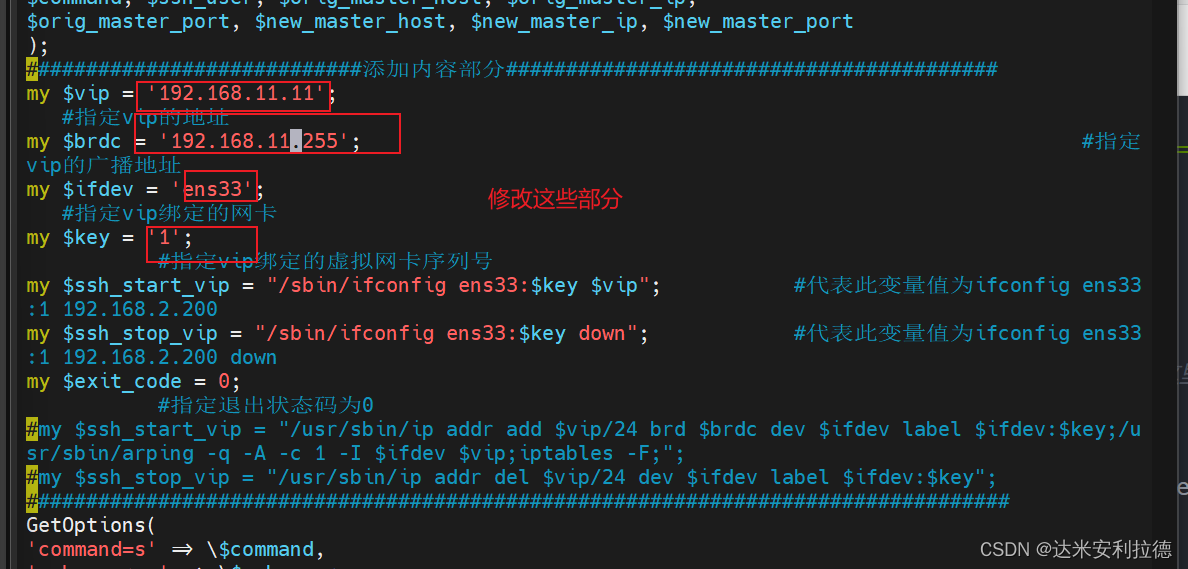
创建 MHA 软件目录并拷贝配置文件,这里使用app1.cnf配置文件来管理 mysql 节点服务器


The configuration file is explained as follows:
[server default]
manager_log=/var/log/masterha/app1/manager.log #manager日志
manager_workdir=/var/log/masterha/app1 #manager工作目录
master_binlog_dir=/usr/local/mysql/data/ #master保存binlog的位置,这里的路径要与master里配置的binlog的路径一致,以便MHA能找到
master_ip_failover_script=/usr/local/bin/master_ip_failover #设置自动failover时候的切换脚本,也就是上面的那个脚本
master_ip_online_change_script=/usr/local/bin/master_ip_online_change #设置手动切换时候的切换脚本
password=manager #设置mysql中root用户的密码,这个密码是前文中创建监控用户的那个密码
ping_interval=1 #设置监控主库,发送ping包的时间间隔,默认是3秒,尝试三次没有回应的时候自动进行failover
remote_workdir=/tmp #设置远端mysql在发生切换时binlog的保存位置
repl_password=123123 #设置复制用户的密码
repl_user=myslave #设置复制用户的用户
report_script=/usr/local/send_report #设置发生切换后发送的报警的脚本
secondary_check_script=/usr/local/bin/masterha_secondary_check -s 192.168.59.111 -s 192.168.59.114 #指定检查的从服务器IP地址
shutdown_script="" #设置故障发生后关闭故障主机脚本(该脚本的主要作用是关闭主机防止发生脑裂,这里没有使用)
ssh_user=root #设置ssh的登录用户名
user=mha #设置监控用户root
[server1]
hostname=192.168.59.118
port=3306
[server2]
hostname=192.168.59.111
port=3306
candidate_master=1
#设置为候选master,设置该参数以后,发生主从切换以后将会将此从库提升为主库,即使这个从库不是集群中最新的slave
check_repl_delay=0
#默认情况下如果一个slave落后master 超过100M的 relay logs的话,MHA将不会选择该slave作为一个新的master, 因为对于这个slave的恢复需要花费很长时间;通过设置check_repl_delay=0,MHA触发切换在选择一个新的master的时候将会忽略复制延时,这个参数对于设置了candidate_master=1的主机非常有用,因为这个候选主在切换的过程中一定是新的master
[server3]
hostname=192.168.59.114
port=3306
在主节点开启虚拟IP、
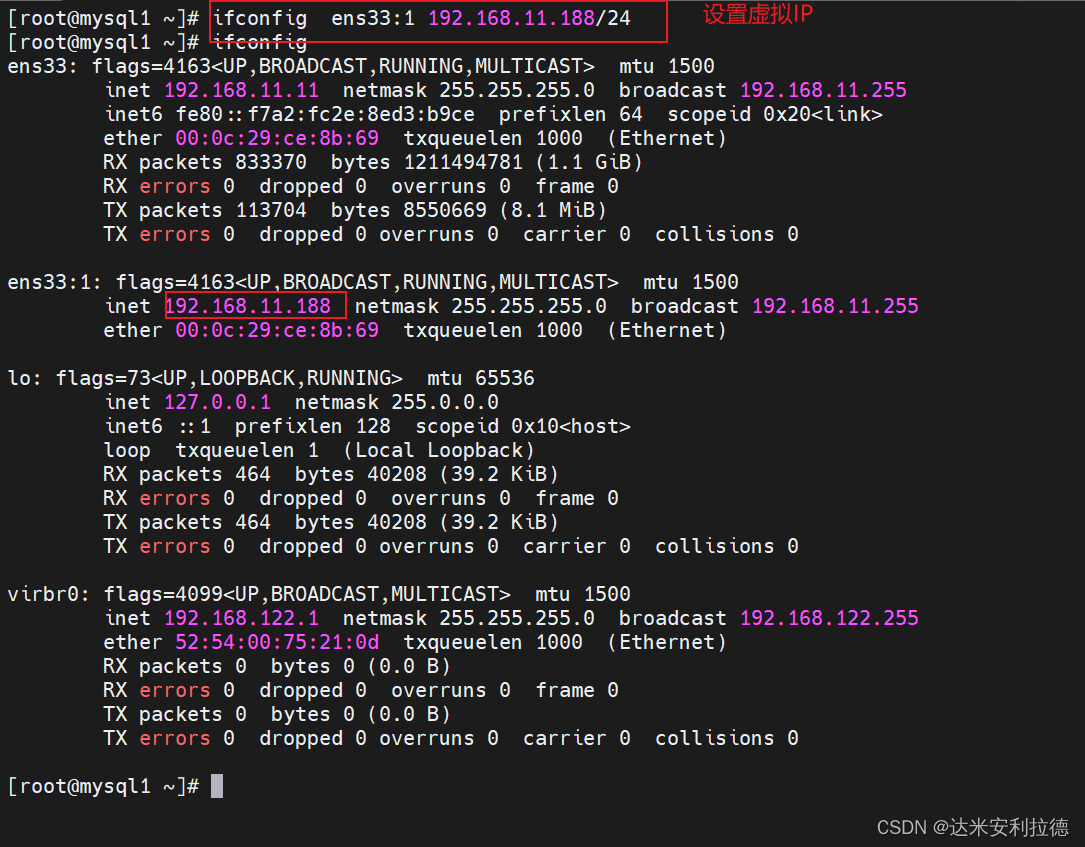
在 manager 节点上测试 ssh 无密码认证,如果正常最后会输出 successfully。如下所示
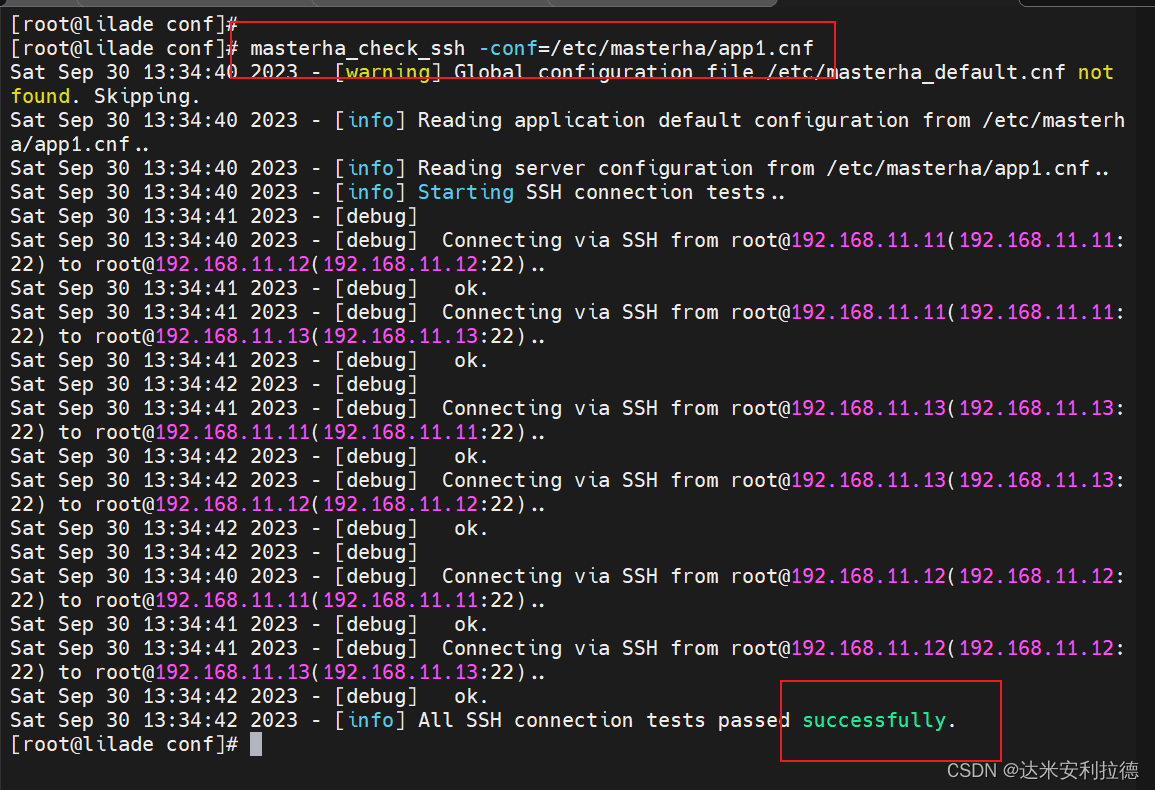
在 manager 节点上测试 mysql 主从连接情况,最后出现 MySQL Replication Health is OK 字样说明正常。如下所示。

在 manager 节点上启动 MHA
nohup masterha_manager \
--conf=/opt/mysql-mha/mysql_mha.cnf \
--remove_dead_master_conf \
--ignore_last_failover < /dev/null > /var/log/mha_manager.log 2>&1 &
# --remove_dead_master_conf:该参数代表当发生主从切换后,老的主库的 ip 将会从配置文件中移除。
# --ignore_last_failover:在缺省情况下,如果 MHA 检测到连续发生宕机,且两次宕机间隔不足 8 小时的话,则不会进行 Failover
#之所以这样限制是为了避免 ping-pong 效应。
#该参数代表忽略上次 MHA 触发切换产生的文件,默认情况下,MHA 发生切换后会在 app1.failover.complete 日志文件中记录,下次再次切换的时候如果发现该目录下存在该文件将不允许触发切换, 除非在第一次切换后删除该文件,为了方便,这里设置为--ignore_last_failover。
#使用&后台运行程序:结果会输出到终端;使用Ctrl+C发送SIGINT信号,程序免疫;关闭session发送SIGHUP信号,程序关闭。
#使用nohup运行程序:结果默认会输出到nohup.out;使用Ctrl+C发送SIGINT信号,程序关闭;关闭session发送SIGHUP信号,程序免疫。
#使用nohup和&配合来启动程序nohup ./test &:同时免疫SIGINT和SIGHUP信号。

查看 MHA 状态
masterha_check_status --conf=/opt/mysql-mha/mysql_mha.cnf
#可以看到当前的主服务器是master1节点

查看 MHA 日志
cat /opt/mysql-mha/manager.log | grep "current master"
#也以看到当前的主服务器是 192.168.11.11

查看master的 VIP 地址是否存在
#关闭 manager 服务
masterha_stop --conf=/opt/mysql-mha/mysql_mha.cnf
#或者可以直接采用 kill 进程 ID 的方式关闭。

2.2. Fault simulation
#在 manager 节点上监控观察日志记录
tail -f /opt/mysql-mha/manager.log
#在Master节点master上停止mysql服务
systemctl stop mysqld
或
pkill -9 mysql



#正常自动切换一次后,MHA 进程会退出
#HMA 会自动修改 app1.cnf 文件内容,将宕机的 master节点删除
#查看slave1是否接管 VIP
ifconfig

vim /opt/mysql-mha/mysql_mha.cnf
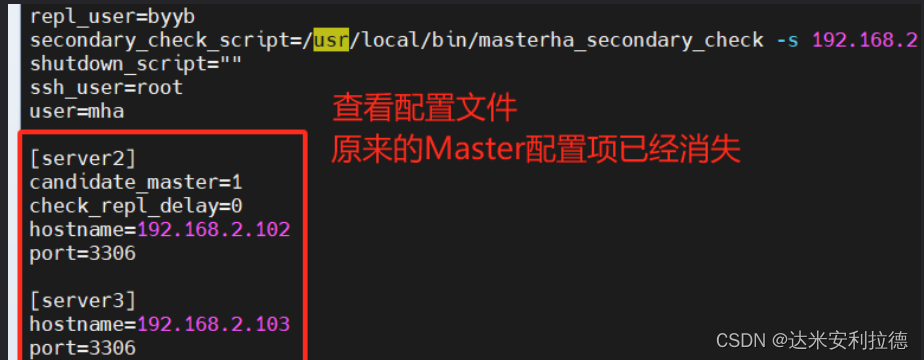
2.3. Fault repair
修复MySQL(原Master)
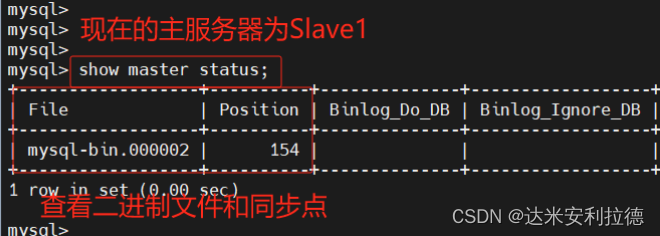
#在原主库服务器master1执行同步操作
change master to master_host='192.168.2.102',master_user='byyb',master_password='123123',master_log_file='mysql-bin.000002',master_log_pos=154;
start slave;
show slave status\G;
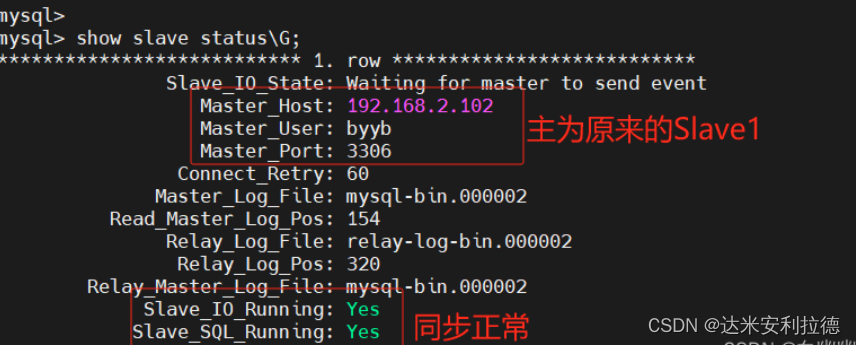
在 manager 节点上修改配置文件
vim /opt/mysql-mha/mysql_mha.cnf
......
secondary_check_script=/usr/local/bin/masterha_secondary_check -s 192.168.2.100 -s 192.168.2.103
......
[server1]
hostname=192.168.2.102
port=3306
[server2]
candidate_master=1
check_repl_delay=0
hostname=192.168.2.100
port=3306
[server3]
hostname=192.168.2.103
port=3306
#此时slave1为主
在 manager 节点上启动 MHA
nohup masterha_manager \
--conf=/opt/mysql-mha/mysql_mha.cnf \
--remove_dead_master_conf \
--ignore_last_failover < /dev/null > /var/log/mha_manager.log 2>&1 &
#解决中英字不兼容报错的问题
dos2unix /usr/local/bin/master_ip_failover